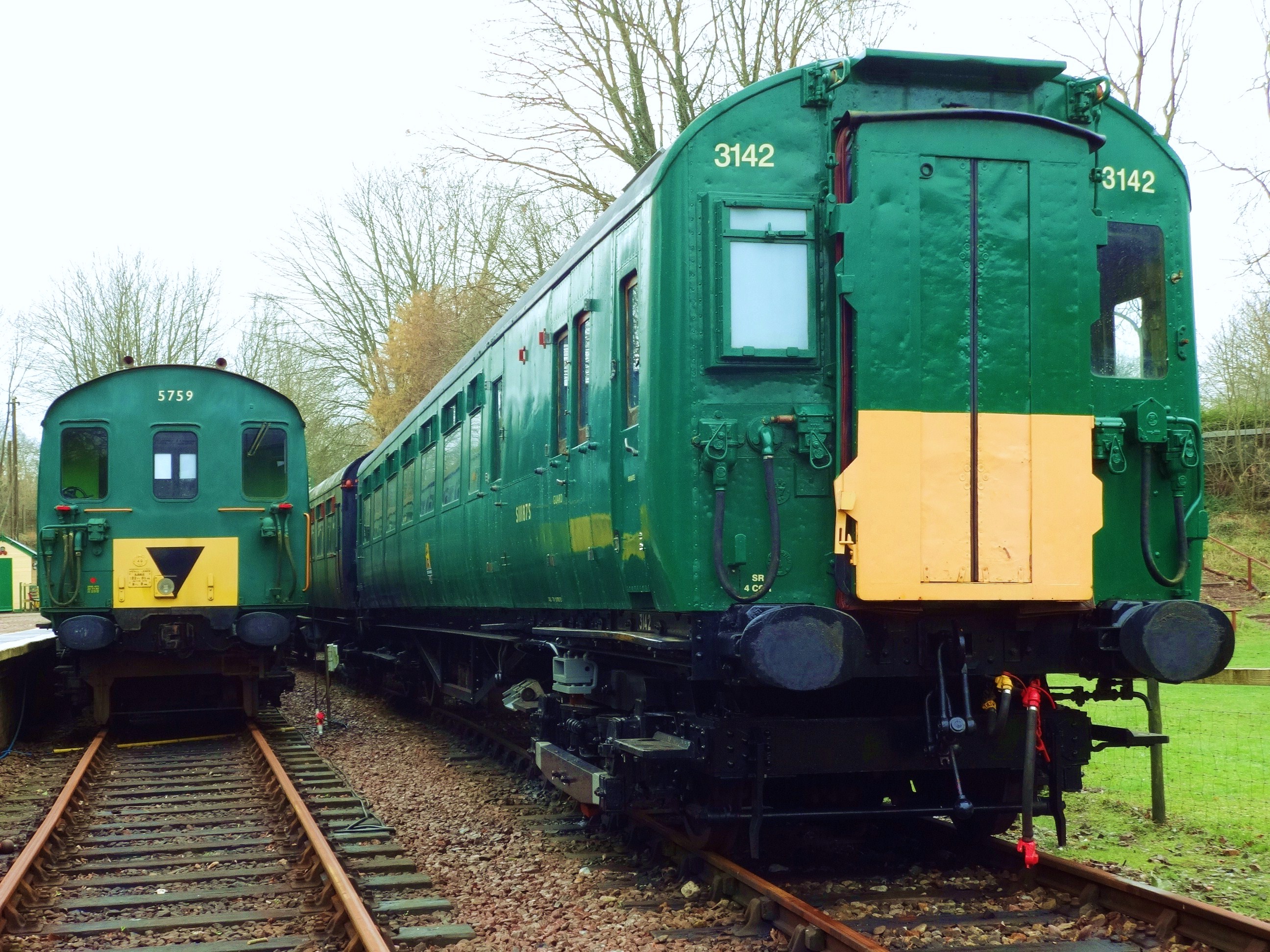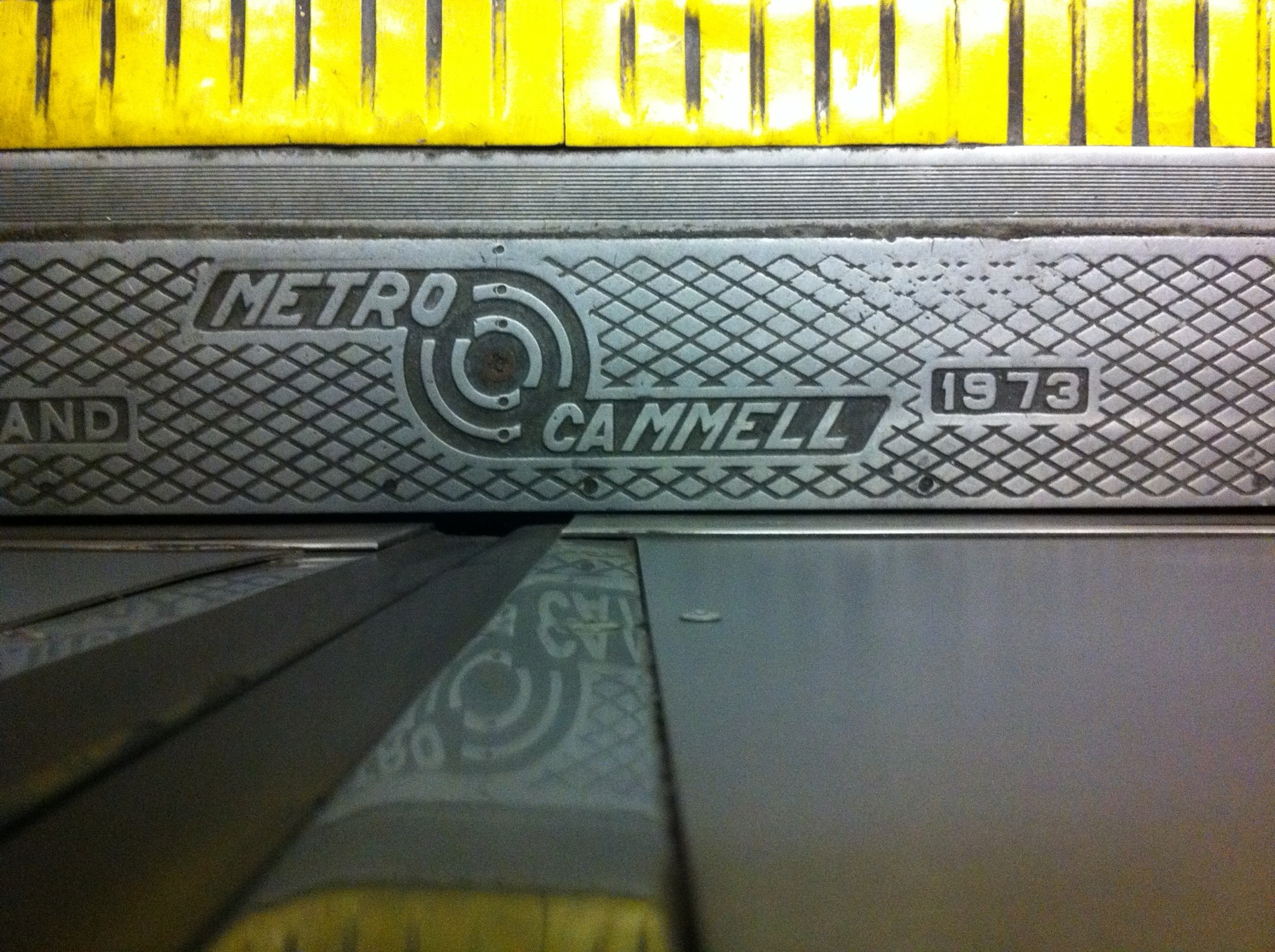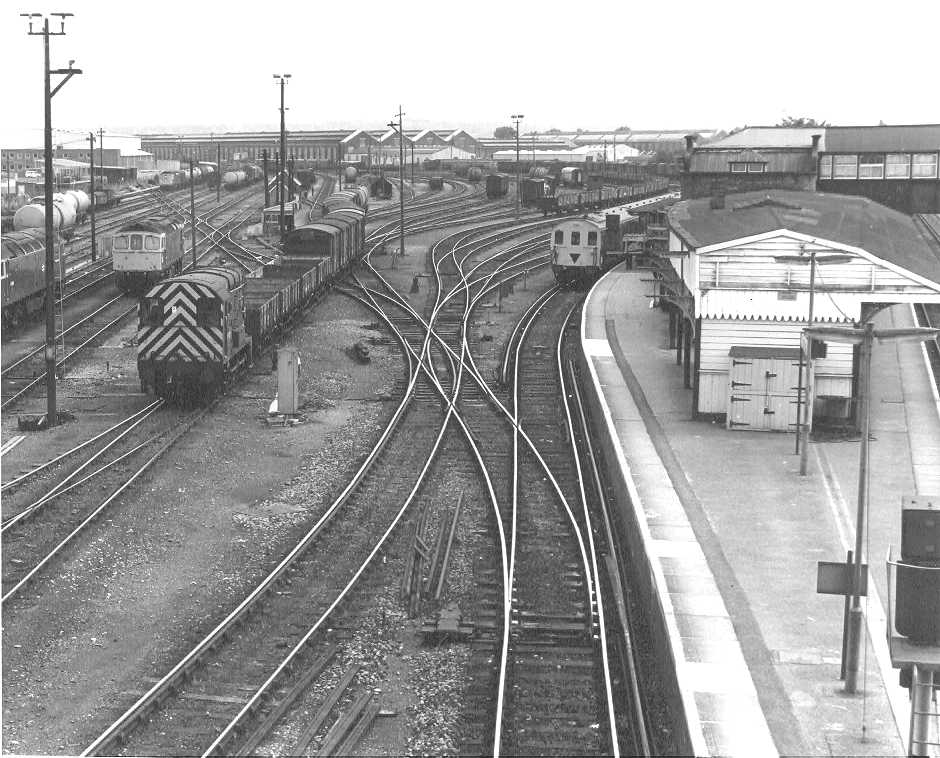|
British Rail Class 404
The Southern Railway (SR) gave the designations 4-COR, 4-RES, 4-BUF and 4-GRI to the different types of electric multiple unit built to work the route between London Waterloo and Portsmouth Harbour. The 4-COR type units survived long enough in British Rail ownership to be allocated TOPS Class 404. The COR designation had previously been used for the 6-PUL units and was reused by them during World War II when the Pullman car was stored, but this stock was different from the 4-COR units. Phase 1 units The SR electrified the London Waterloo to Portsmouth Harbour via Woking line in the mid-1930s, and full electric services commenced over the route from April 1937. For this service, 29 4-COR units (4-car Corridor units, numbered 3101–3129) and 19 4-RES units (4-car Restaurant units, numbered 3054–3072) were built. Corridor connections were provided throughout each unit, including between units. This gave them a distinctive front-end appearance as the headcode display was place ... [...More Info...] [...Related Items...] OR: [Wikipedia] [Google] [Baidu] |
Lancing Works
Lancing may refer to: *Lancing (surgical procedure), a minor surgical procedure to release pus or pressure built up under the skin * Lancing (shearing), a manufacturing procedure involving a workpiece sheared and bent with one strike of a die *Lancing, West Sussex, England, a village in West Sussex between Worthing and Shoreham-by-Sea * Lancing (electoral division), a West Sussex County Council constituency *Lancing College, an English public school * Lancing railway station, a British railway station operated by Southern on the West Coastway line *Lancing Carriage Works Lancing Carriage Works was a railway carriage and wagon building and maintenance facility in the village of Lancing near Shoreham-by-Sea in the county of West Sussex in England from 1911 until 1965. History under the LB&SCR The cramped situati ..., a defunct railway site in the village of Lancing, West Sussex See also * Lance (other) * Lansing (other) {{Disambiguation ... [...More Info...] [...Related Items...] OR: [Wikipedia] [Google] [Baidu] |
TOPS
Total Operations Processing System (TOPS) is a computer system for managing railway locomotives and rolling stock, known for many years of use in the United Kingdom. TOPS was originally developed between the Southern Pacific Railroad (SP), Stanford University and IBM as a replacement for paper-based systems for managing rail logistics. A jointly-owned consultancy company, ''TOPS On-Line Inc.'', was established in 1960 with the goal of implementing TOPS, as well as selling it to third parties. Development was protracted, requiring around 660 man-years of effort to produce a releasable build. During mid-1968, the first phase of the system was introduced on the SP, and quickly proved its advantages over the traditional methods practiced prior to its availability. In addition to SP, TOPS was widely adopted throughout North America and beyond. While it was at one point in widespread use across many of the United States railroads, the system has been perhaps most prominently use ... [...More Info...] [...Related Items...] OR: [Wikipedia] [Google] [Baidu] |
London Transport Museum
The London Transport Museum (LTM) is a transport museum based in Covent Garden, London. The museum predominantly hosts exhibits relating to the heritage of Transport in London, London's transport, as well as conserving and explaining the history of it. The majority of the museum's exhibits originated in the collections of London Regional Transport, London Transport, but, since the creation of Transport for London (TfL) in 2000, the remit of the museum has expanded to cover all aspects of transport in the city and in some instances beyond. The museum operates from two sites within London. The main site in Covent Garden uses the name of its parent institution, and is open to the public every day, excluding over Christmas, having reopened in 2007 after a two-year refurbishment. The other site, located in Acton, London, Acton, is the London Transport Museum Depot and is principally a storage site of historic artefacts that is open to the public on scheduled visitor days throughout ... [...More Info...] [...Related Items...] OR: [Wikipedia] [Google] [Baidu] |
Bluebell Railway
The Bluebell Railway is an heritage line in West Sussex in England. It is managed by the Bluebell Railway Preservation Society. It uses steam trains which operate between and , with intermediate stations at and . It is the first preserved standard gauge steam-operated passenger railway in the world to operate a public service. The society ran its first train on 7 August 1960, less than three years after the line from East Grinstead to Lewes had been closed by British Railways. On 23 March 2013, the Bluebell Railway started to run through to its new terminus station. At East Grinstead there is a connection to the national rail network, the first connection of the Bluebell Railway to the national network in 50 years, since the Horsted Keynes – line closed in 1963. Today the railway is managed and run largely by volunteers. Having preserved a number of steam locomotives even before steam stopped running on British mainline railways in 1968, today it has over 30 steam l ... [...More Info...] [...Related Items...] OR: [Wikipedia] [Google] [Baidu] |
Nene Valley Railway
The Nene Valley Railway (NVR) is a Heritage railway, preserved railway in Cambridgeshire, England, running between and Yarwell Junction. The line is in length. There are stations at each terminus, and three stops en route: , and . History Origins In 1845, the London and Birmingham Railway (L&BR) company was given parliamentary assent to construct a line from Blisworth in Northamptonshire to Peterborough. Completed in 1847, it was Peterborough's first railway line. It terminated at Peterborough, later Peterborough East railway station, 'Peterborough East' station. The line was of little significance until the late 19th century, when the London & North Western Railway (L&NWR), which had absorbed the L&BR, constructed a line via Nassington and King's Cliffe to Seaton, Rutland, Seaton, below Welland Viaduct. This turned Wansford, Cambridgeshire, Wansford, previously an unimportant village station, into a major junction. Its importance increased a few years later when the Grea ... [...More Info...] [...Related Items...] OR: [Wikipedia] [Google] [Baidu] |
4COR Unit 3142 At LT Museum Depot
The Southern Railway (SR) gave the designations 4-COR, 4-RES, 4-BUF and 4-GRI to the different types of electric multiple unit built to work the route between London Waterloo and Portsmouth Harbour. The 4-COR type units survived long enough in British Rail ownership to be allocated TOPS Class 404. The COR designation had previously been used for the 6-PUL units and was reused by them during World War II when the Pullman car was stored, but this stock was different from the 4-COR units. Phase 1 units The SR electrified the London Waterloo to Portsmouth Harbour via Woking line in the mid-1930s, and full electric services commenced over the route from April 1937. For this service, 29 4-COR units (4-car Corridor units, numbered 3101–3129) and 19 4-RES units (4-car Restaurant units, numbered 3054–3072) were built. Corridor connections were provided throughout each unit, including between units. This gave them a distinctive front-end appearance as the headcode display was place ... [...More Info...] [...Related Items...] OR: [Wikipedia] [Google] [Baidu] |
Dorset
Dorset ( ; Archaism, archaically: Dorsetshire , ) is a Ceremonial counties of England, ceremonial county in South West England. It is bordered by Somerset to the north-west, Wiltshire to the north and the north-east, Hampshire to the east, the Isle of Wight across the Solent to the south-east, the English Channel to the south, and Devon to the west. The largest settlement is Bournemouth, and the county town is Dorchester, Dorset, Dorchester. The county has an area of and a population of 772,268. Around half of the population lives in the South East Dorset conurbation, which contains three of the county's largest settlements: Bournemouth (183,491), Poole (151,500), and Christchurch, Dorset, Christchurch (31,372). The remainder of the county is largely rural, and its principal towns are Weymouth, Dorset, Weymouth (53,427) and Dorchester, Dorset, Dorchester (21,366). Dorset contains two Unitary authorities in England, unitary districts: Bournemouth, Christchurch and Poole (BCP) ... [...More Info...] [...Related Items...] OR: [Wikipedia] [Google] [Baidu] |
Steam Locomotive
A steam locomotive is a locomotive that provides the force to move itself and other vehicles by means of the expansion of steam. It is fuelled by burning combustible material (usually coal, Fuel oil, oil or, rarely, Wood fuel, wood) to heat water in the locomotive's Boiler (power generation), boiler to the point where it becomes gaseous and its volume increases 1,700 times. Functionally, it is a steam engine on wheels. In most locomotives, the steam is admitted alternately to each end of its Steam locomotive components, cylinders in which pistons are mechanically connected to the locomotive's main wheels. Fuel and water supplies are usually carried with the locomotive, either on the locomotive itself or in a Tender (rail), tender coupled to it. #Variations, Variations in this general design include electrically powered boilers, turbines in place of pistons, and using steam generated externally. Steam locomotives were first developed in the United Kingdom of Great Britain an ... [...More Info...] [...Related Items...] OR: [Wikipedia] [Google] [Baidu] |
London Waterloo Railway Station
Waterloo station (), also known as London Waterloo, is a major London station group, central London railway terminus on the National Rail network in the United Kingdom, in the Waterloo, London, Waterloo area of the London Borough of Lambeth. It is connected to a London Underground Waterloo tube station, station of the same name and is adjacent to Waterloo East railway station, Waterloo East station on the South Eastern Main Line. The station is the terminus of the South West Main Line to via Southampton, the West of England line, West of England main line to Exeter via , the Portsmouth Direct line to which connects with ferry services to the Isle of Wight, and several commuter services around west and south-west London, Surrey, Hampshire and Berkshire. The station was opened in 1848 by the London and South Western Railway, and it replaced the earlier as it was closer to the West End of London, West End. It was never designed to be a terminus, as the original intention was ... [...More Info...] [...Related Items...] OR: [Wikipedia] [Google] [Baidu] |
Metropolitan Cammell
Metro-Cammell, formally the Metropolitan Cammell Carriage and Wagon Company (MCCW), was an English manufacturer of railway carriages, locomotives and railway wagons, based in Saltley, and subsequently Washwood Heath, in Birmingham. The company was purchased by GEC Alsthom in May 1989; the Washwood Heath factory closed in 2005 and was demolished in early 2019. The company designed and built rolling stock for the railways in the United Kingdom and overseas, including the Mass Transit Railway of Hong Kong, Kowloon–Canton Railway (now East Rail line), the Channel Tunnel, and the Tyne and Wear Metro, and locomotives for Malaysia's Keretapi Tanah Melayu. Diesel and electric locomotives were manufactured for South African Railways, Nyasaland Railways, Malawi, Nigeria, Trans-Zambezi Railway and Pakistan. DMUs were supplied to Jamaica Railway Corporation and the National Railways of Mexico. The vast majority of London Underground rolling stock manufactured in the mid-20th cen ... [...More Info...] [...Related Items...] OR: [Wikipedia] [Google] [Baidu] |
Birmingham Railway Carriage And Wagon Company
The Birmingham Railway Carriage and Wagon Company (BRC&W) was a railway locomotive and carriage builder, founded in Birmingham, England and, for most of its existence, located at nearby Smethwick, with the factory divided by the boundary between the two places. The company was established in 1854. Production BRC&W made not only carriages and wagons, but a range of vehicles, from aeroplanes and military gliders to buses, trolleybuses and tanks. Nevertheless, it is as a builder of railway rolling stock that the company is best remembered, exporting to most parts of the new and old worlds. It supplied vehicles to all four of the pre-nationalisation "big four" railway companies (London, Midland and Scottish Railway, LMS, Southern Railway (UK), SR, London and North Eastern Railway, LNER and Great Western Railway, GWR), British Rail, Pullman Company, Pullman (some of which are still in use) and Compagnie Internationale des Wagons-Lits, Wagons-Lits, plus overseas railways with dive ... [...More Info...] [...Related Items...] OR: [Wikipedia] [Google] [Baidu] |
Eastleigh Works
Eastleigh Works is a locomotive, carriage and wagon building and repair facility in the town of Eastleigh, in the county of Hampshire in England. History LSWR The London and South Western Railway (LSWR) opened a carriage and wagon works at Eastleigh in 1891. In 1903, the Chief Mechanical Engineer, Dugald Drummond, oversaw the construction of a large motive power depot in the town; replacing the existing maintenance and repair shops at Northam, Southampton. In January 1910, locomotive building was likewise transferred to the new workshops at Eastleigh from Nine Elms Locomotive Works, Nine Elms in London. The first locomotives built at Eastleigh were the two LSWR S14 class, S14 delivered in September 1910, and these were followed by Eastleigh's first tender locomotives, the five LSWR P14 class, P14 , delivered between October 1910 and February 1911. Among the other locomotives produced by the LSWR under Drummond at Eastleigh, were the LSWR M7 Class, M7 0-4-4 tank engines, the L ... [...More Info...] [...Related Items...] OR: [Wikipedia] [Google] [Baidu] |








